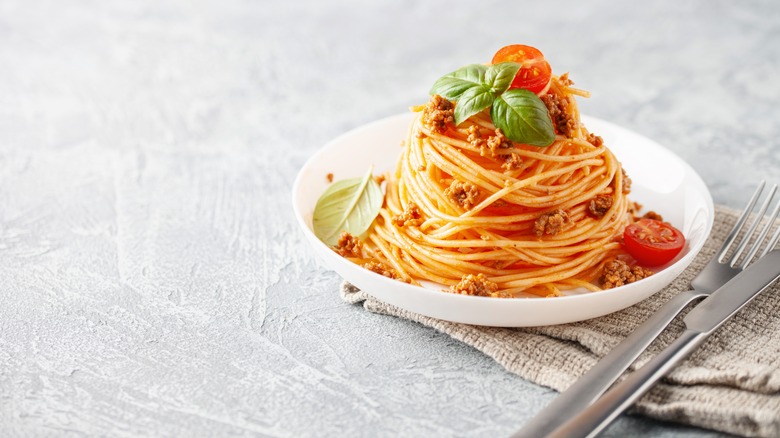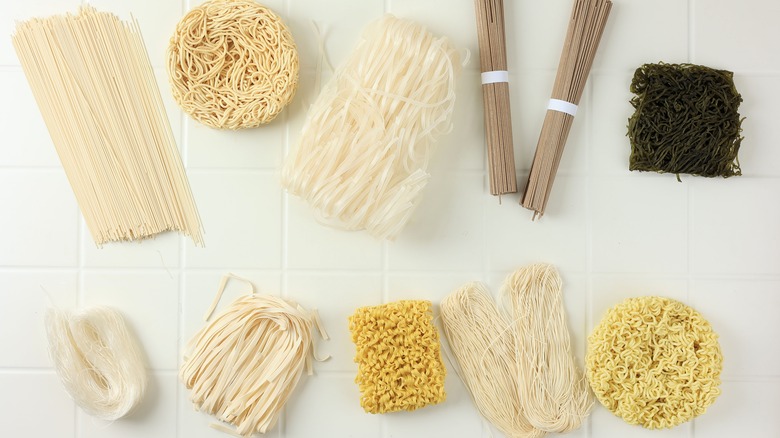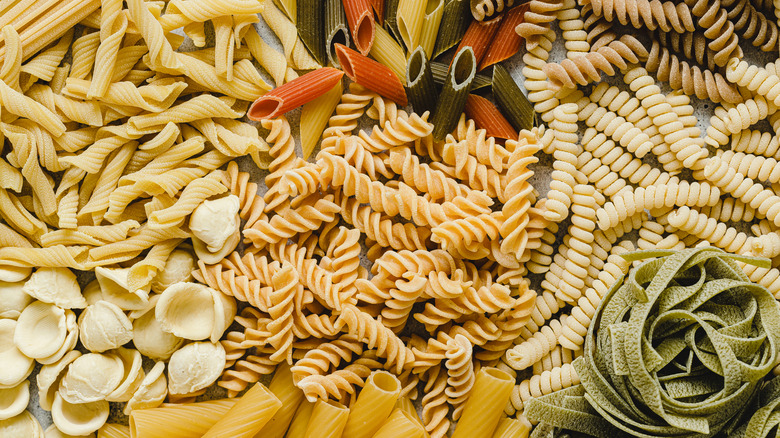The Myth And Mystery Behind The Invention Of Italian Pasta
Pasta is one of the world's most popular foods and an international symbol of Italy, where the average person consumes roughly 50 pounds of it every year, according to Statista. It's a daily staple in the country and certainly a source of pride for Italians, but pasta's origins are not Mediterranean. Archaeologists in China discovered a bowl of noodles preserved under an ancient flood site, dating back 4,000 years, millennia before any evidence of pasta in Italy. What's more, pasta seems not to be a doppelgänger of Asian noodles, but rather a direct descendant. The question is, how did this evolution occur?
Many have heard the story that Marco Polo introduced pasta to Italy after encountering noodles during his 13th-century journey to China. Polo wrote about his travels in the creatively-titled book "The Travels of Marco Polo," which mentions a plant used to make pasta-like dishes. The exact wording of this passage is unknown since Polo's original text has been lost, and the story has only survived through retellings. Historians suspect he was likely referring to the sago tree, used to make a food similar to acini di pepe, the tiny spherical pasta featured in Italian wedding soup. However, whatever Polo encountered on his travels, it could not have been the inspiration for pasta, as it was already present in Italy by that time.
The true origins of pasta
Tracing the history of pasta in Italy is complex, partly due to its name. "Pasta" simply means "paste" in Italian, referring to the dough's soft texture. This ambiguity makes it difficult for historians to distinguish references to pasta from other dough-based foods. It doesn't help that pasta's historical role as a staple for the economically disadvantaged means that its history is less frequently documented.
The story of Marco Polo does fall in line with the historical consensus that pasta is descended from Chinese noodles. However, the idea that it was Polo who created that cross-cultural connection is entirely false. There is ample historical evidence against it, including Italian texts from the 1270s-80s, the same decades that Polo was off exploring China, which mention maccheroni and vermicelli, familiar pasta shapes to this day. More than a century before that, in 1154, the Arab trader and geographer Idrisi wrote of cooks making pasta on the island of Sicily.
But if not by Marco Polo, how then did noodles really reach Italy and give rise to the many forms of pasta we know today? In reality, it was not a singular moment of discovery, but rather a gradual evolution that occurred over centuries with the expansion of global trade routes. Merchants from China brought noodles westward to the Middle East, where their evolution into pasta really got started.
The evolution of pasta
Not all noodles are pasta, of course, and it's more accurate to say that pasta evolved rather than was invented. If there's a moment that could be pinpointed as the origin of pasta, it would likely be in the Middle East, where people first started making noodles with a local variety of wheat known as durum. Indeed, long, strand-shaped pastas like spaghetti and vermicelli are thought to have originated in the Arab world, from where traders brought them to Italy around the ninth or 10th century. Subsequently, farmers in Sicily began cultivating durum wheat, setting the stage for Italy's pasta obsession.
The earliest pasta dishes in Italy differed significantly from today's popular varieties. In fact, the original pasta versions were never cooked al dente, but were boiled for extended periods. An early recipe from Bartolomeo Scappi, a papal cook considered the first celebrity chef, suggests boiling sheets of pasta for half an hour and then baking them for another half. Pasta's early iterations also featured surprising ingredients, including raisins, cinnamon, and yes, even sugar.
Remarkably, many of today's beloved pasta dishes were not created until the 19th century, when tomatoes were incorporated into the Italian diet. The earliest known tomato sauce recipe dates back to the 1840s, just before the wave of Italian immigration to the U.S.


